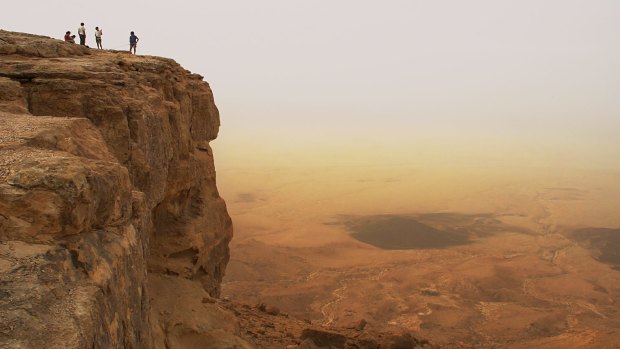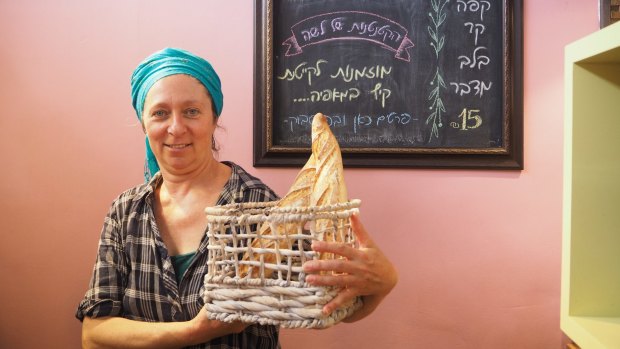
Israel's Negev Desert is harsh and yet also a source of top-drawer produce. Credit: Shutterstock
Israel's Negev desert is not a forgiving place. For more than an hour we've been driving through the great nothingness of it, winding up the ominously-named Scorpion's Ascent that leads from the Arava Valley to the Negev Highlands. Across the vast plains of biscuit-coloured stone we've seen no signs of life bar a few blue-green tufts of saltbush and one lone (and possibly insane) cyclist pushing through the 40-degree heat. Our guide says that if my Kiwi travel companion and I jumped out of our van for a hike right now, it's so hot we may suffer the same fate as a recent teenage hiker who, due to the extreme temperatures, never made it out alive.
In desert terms the Negev is very small; at 13,000 square kilometres it's roughly 700 times smaller than the Sahara. Yet in Israeli terms it's enormous, taking up about 60 per cent of the country's land mass. It's also extremely dry, receiving less than 100 millimetres of rain per year. So when we arrive at our home for the night, a small farm and vineyard called Carmey Avdat that's an oasis of lush vines, gardens and trees heavy with figs, pomegranates and olives, it's completely surprising. But as we're about to find out, the Negev is dotted with dozens of artisanal food producers and boutique wineries just like it, set out along the Ramat HaNegev wine route.
Created in an attempt to re-establish the agriculture and lifestyle that existed along the ancient spice route that once wove through the Negev, this wine route is giving travellers a reason to stay longer in this region.

Hadas Meir, who owns Lasha Bakery in Mitzpe Ramon, with some of her handmade loaves. Credit: Nina Karnikowski
After settling into my charming desert cabin, one of six set on the hill overlooking the farm, I head down to the winery for a tasting. The Negev Highlands are set at about 600 metres above sea level and the combination of the high altitude, cold desert nights and hot days create an ideal climate for grape growing, the proof of which is in Carmey Avdat's flavoursome, hand-harvested cabernet sauvignons and merlots. Winemaking in the Negev, says the young Israeli woman holding our tasting, has been happening since ancient times. Wine presses and cellars dating back to the time of the Nabataeans, the ancient desert nomads, have been excavated here. Carmey Avdat itself is set on the remains of a 2000-year-old Nabataean vineyard and the owners still use the ancient terracing and irrigation systems they found when they started their farm here in 1998.
The next morning we set off to explore more of this unexpected food bowl. We start at Naot Goat Farm, one of several goat farms scattered along the wine route. On the terrace of the farm's small shop we meet the blue-eyed, silver-haired owner Lea Nachimov, who established this farm with her bearded husband Gadi 14 years ago.
"When we first arrived with our six children and 50 goats from Jerusalem, there was nothing here," says Nachimov, pressing glasses of cool goat yoghurt into our hands. "We slept in a tent for the first few weeks, then a container, but we didn't have water or electricity for a while, we had to build it all ourselves." The Nachimov's now have 80 goats for producing milk, yoghurt and cheese, plus 50 sheep for meat, products that they sell in their small store and to guests staying in their five rustic, self-catered cabins. Fourteen years on, Nachimov says that running this business in the middle of the desert still isn't easy. But as I'm starting to discover, the Negev seems to attract resilient, creative residents like this, who draw inspiration from the wild weather and isolation.
To get a true sense of the Negev's remoteness, we've been told we need to visit the Makhtesh Ramon, Israel's version of the Grand Canyon. A guided Jeep tour takes us around the crater's edge, where we get a spectacular view into what we're told is the world's largest erosion crater, then 300 metres down into the yawning chasm. There, surrounded by towering walls of lemon, rose and tangerine sandstone, we're shown snail-sized ammonite fossils as evidence of how this 40-kilometre crater was created 220 million years as the Negev evolved from ocean to desert. What's most impressive about this geological phenomenon, though, is how it makes me suddenly feel that I'm no longer in a country 367 times smaller than my own, but somewhere very vast indeed.
Later in the afternoon, we find ourselves eating lunch with a woman whose life was transformed by the expansive feeling of the Negev. Hadas Meir is the owner of Lasha Bakery in Mitzpe Ramon, the dusty desert town of about 5000 people, many of them New Age hippie types escaping big city life, on the northern edge of the crater. Sitting in the courtyard of her boutique bakery sipping Negev chardonnay and nibbling her crumbly cheese sticks, Meir tells us that nine years ago she was living a completely different life. Back then in Tel Aviv, she was successful in her corporate marketing career, but she wasn't happy. Until the weekend she decided to come to Mitzpe Ramon for a break.
"One morning I was watching the sunrise here and suddenly, I remembered who was living inside of me." Just like that, Meir decided to move here, to what she describes as "heaven for creative people". "I was full of trust, all I was sure of was that I had to be here," says Meir with a smile as she adjusts her turquoise head wrap. She started baking when she arrived; when friends started wanting to buy her creations she began selling them from her home, until five years ago when she finally opened Lasha.
Meir's bread is excellent, made using traditional techniques in stone ovens, but it's her approach that makes her product truly unique. "What I do here is magic, it's spiritual," she says. For Meir, baking is a way to connect to Judaism. She and her staff pray to the bread as they bake, and the white tiles lining the walls of her bakery are scrawled with Hebrew blessings. She also runs various baking courses and workshops involving meditation and ceremony, some even held inside the crater.
"When people learn how to bake bread properly – with spirituality, magic and beauty – I'm certain their lives become better, and the lives of the people they live with become better, too," she says. Maybe it's just the desert air getting to me, but something about the sparkle in her eye makes me almost believe it.
TRIP NOTES
MORE
FLY
Cathay Pacific Airways flies to Tel Aviv via Hong Kong from every capital city for about $1550 return. Mitzpe Ramon is an easy two-and-a-half-hour drive south from Tel Aviv. See cathaypacific.com
STAY
Carmey Avdat Farm has six eco-friendly guest cabins, each with their own deck and dipping pool. From $180 a night; carmeyavdat.com
For the ultimate luxury desert experience, Beresheet Hotel is set right on the edge of Ramon Crater. Many of the 111 rooms (39 with private plunge pools) have spectacular crater views, but the best can be found from the cliff-edge infinity pool. From about $440 a night; isrotel.com
EAT
To book a baking class at Lasha Bakery, contact lashabakery@gmail.com
Other vineyards worth visiting along the wine route include Sde Boker Winery, Yatir Winery (yatirwinery.com) and Boker Valley Vineyard see bokerfarm.com
Nina Karnikowski travelled courtesy of the Embassy of Israel and Cathay Pacific Airways.
FIVE OTHER THINGS TO SEE AND DO IN THE NEGEV DESERT
VISIT AVDAT NABATAEAN SETTLEMENT
This beautifully preserved city was built in the 3rd century BC as a caravan stop on the road from Petra to the Mediterranean. See catacombs, a Roman bathhouse, 4th-century churches and a Byzantine wine press.
CHECK OUT THE SPICE ROUTE QUARTER
You'll find this group of warehouses, once used by the military but now housing hippy-style artisanal stores, artists' studios, cafes and a dance workshop, on the northern edge of Mitzpe Ramon.
HAVE A CRATER ADVENTURE
Arrange a day of hiking, rappelling or biking through the Ramon Crater, topped off with a night of camping under the stars, via negevland@gmail.com
EXPLORE EN AVDAT NATIONAL PARK
Home to freshwater springs and waterfalls, hiking trails and caves that were once inhabited by monks during the Byzantine period, En Avdat sits next to Kibbutz Sde Boker, the erstwhile home of Israel's beloved first Prime Minister David Ben-Gurion.
HORSE RIDE FROM THE ALPACA FARM
You'll find this alpaca and llama farm next to the ridge of the Ramon Crater – it's a great place to begin a horseback ride around, or inside, the crater. See alpacas-farm.com
Sign up for the Traveller Deals newsletter
Get exclusive travel deals delivered straight to your inbox. Sign up now.